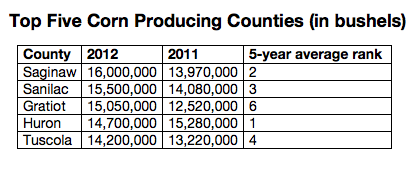
Drought-resistant corn may still come in handy – despite recent rain and flooding, farmers agree Michigan’s weather is often unpredictable. Photo: Michigan Farm Bureau
Despite heavy rain, flooding and cold weather, drought-resistant corn could still be helpful to farmers this season.
Michigan Corn Growers Association leaders agreed that recent wet weather won’t be bad for corn designed to withstand drought conditions because it will be planted in areas that don’t hold water as well.
They added that the corn could still serve its original purpose if there’s little rain in July and August.
“Just because we have a bunch of rain now doesn’t mean there won’t be a drought later,” said Scott Lonier, owner of Shady Lodge Farm in Lansing Township and president of the association.
However, he said he didn’t buy drought-resistant corn this year because it didn’t yield much better than refuge corn — corn that’s not genetically modified — last year.
Drought-resistant corn costs about 20 percent more than other types, Lonier said, but farmers who bought it didn’t waste their money since weather and corn change from year to year.
“The only constant we have in this business is that every year is different,” he said.
Unpredictable changes in weather make farmers do a lot of guesswork when deciding which varieties to buy and when to plant.
Lonier said, “We liken it to a dog chasing its tail, and we don’t find out if we caught it until harvest.”
Jeff Sandborn, owner of Sandborn Farms in Portland and chair of the association’s board of directors, said this will be his first year with drought-resistant corn and he’ll plant it in an area that doesn’t hold water as well.
After last summer’s drought, many farmers bought hybrid seed to protect themselves against the chance of excess heat and less-than-normal water.
Sandborn said that to get the best seed and prices, farmers often have to buy for the following year before the corn has been harvested, which makes it difficult to determine what will be needed.
He said the main difference between drought-resistant and regular corn is that the former survives drought conditions for a few weeks longer than the latter.
“We didn’t need five to six inches of rain in one week, but I’d rather get it now than after the seed is planted,” Sandborn said.
The main negative effect of the rain, he said, will be to delay planting.
“Normally we would start planting by now,” he said. But it will likely be pushed back into May.
“Mother Nature knows when to plant corn,” Sandborn said, adding that the ideal planting time is usually when trees begin to bloom.
He said that going from one extreme to the other between years adds to the stress of farming, but 2013 is closer to normal and is preferable to conditions in 2012.
The total Michigan yield dropped significantly in 2012, from more than 335 million bushels in 2011 to less than 318 million. This was the biggest one-year reduction in corn in more than 10 years — yield has trended upward.

2012 corn yield dropped significantly in most counties, but four of the top five produced more bushels than in 2011. Photo: Michigan Corn Growers Association
Sandborn said he’s heard that about every 20 years there are dramatic swings in weather and then for the next 20 years, it’s more normal.
Earl Collier, owner of Collier Farms in Hopkins and an association board member, said despite recent flooding in his fields, he’s glad he bought drought-resistant corn.
“We don’t know what it will be like in July,” he said. “It’s always a tossup — always different.”
This will be his first year with the hybrid.
Bob Boehm, manager of the commodity and marketing department at the Michigan Farm Bureau, said, “Nobody’s panicking yet. But, if two weeks from now we’re still treading water, it will be a different story.”
Although many areas of West Michigan are flooded, he said low lake levels are letting the water drain out faster, which is good news for corn farmers as they get ready to plant.
Boehm said that even in areas where the flooding was severe, higher-level fields will get planted soon.